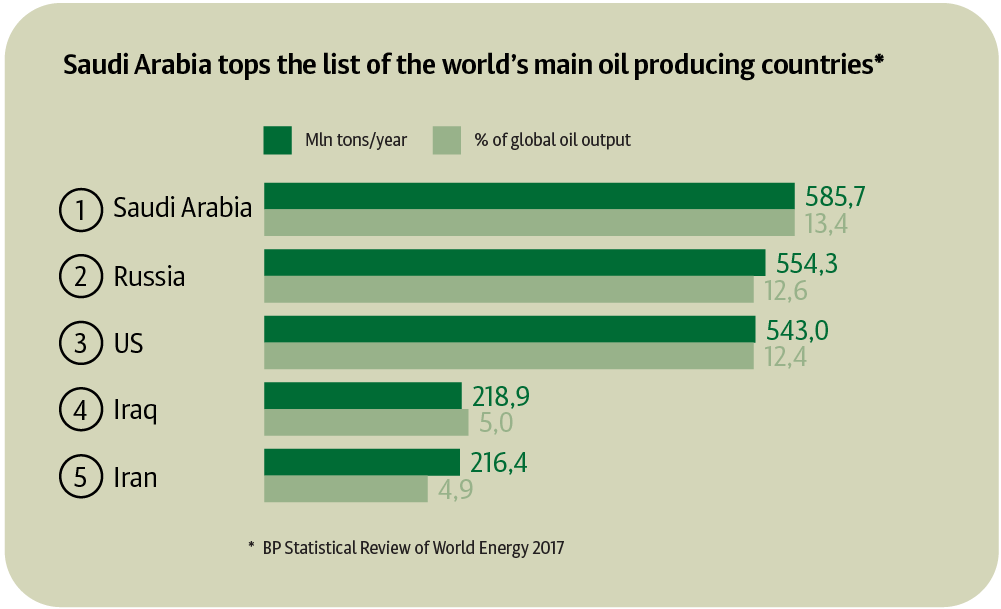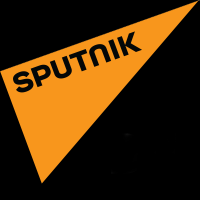Saudi Arabia
The Kingdom
of Sun, Youth, and Oil
of Sun, Youth, and Oil
Saudi Arabia's King Salman bin Abdulaziz Al Saud is visiting Moscow from October 4-7 in what is hoped to be a historic visit. In Russia, the King is scheduled to meet with President Vladimir Putin and sign a range of new bilateral cooperation accords. Sputnik has compiled a brief roundup of Saudi Arabia's traditions, laws and cultural highlights, its diplomatic and trade cooperation with Russia, as well as joint investment projects.
Photo: View of Abraj Al bait complex from the roof of the Masjid al-Haram mosque, Mecca. © Sputnik: Mikhail Voskresenskiy
Facts and Figures
Saudi Arabia on the map

It is necessary to choose a visual aid that is appropriate for the material and audience.
The Kingdom of Saudi Arabia is located on the Arabian Peninsula, between the Arabian Gulf and the Red Sea and shares common borders with Yemen, Oman, the United Arab Emirates, Qatar Kuwait, Iraq, and Jordan. The capital is Riyadh. Its largest cities are Riyadh, Jeddah, Mecca, and Medina.
Mecca is the birthplace of the Prophet Muhammad and the focal point of Hajj, the Islamic pilgrimage in which millions of Muslims from all over the world participate every year. Medina is the city where Prophet Muhammad emigrated and lived.
Riyadh, located in the central province, is also the high-tech center of modern Saudi Arabia and houses the headquarters of the Gulf Cooperation Council (GCC). Jeddah, located along the eastern coast of the Red Sea, is the commercial capital of Saudi Arabia, and serves as an entrance to the rest of the peninsula. Jeddah's ports are the main thoroughfares for trade.
Mecca is the birthplace of the Prophet Muhammad and the focal point of Hajj, the Islamic pilgrimage in which millions of Muslims from all over the world participate every year. Medina is the city where Prophet Muhammad emigrated and lived.
Riyadh, located in the central province, is also the high-tech center of modern Saudi Arabia and houses the headquarters of the Gulf Cooperation Council (GCC). Jeddah, located along the eastern coast of the Red Sea, is the commercial capital of Saudi Arabia, and serves as an entrance to the rest of the peninsula. Jeddah's ports are the main thoroughfares for trade.
Area and Population
Saudi Arabia has a territory of 2.1 million square kilometers and a population of over 30 million, about 80 percent of whom live in the cities and approximately two-thirds of whom are under the age of 30
Religion and Language
The official religion is Islam.
The main language is Arabic
The main language is Arabic
Political System
Monarchy
| Climate Subtropical in the north and tropical in the south. Summers are hot and winters are warm. Summer temperatures shoot up to 50 degrees Celsius (122 degrees Fahrenheit) and daytime winter temperatures never drop below 10 degrees Celsius (50 degrees Fahrenheit). The average annual precipitation level is a mere 100 mm (3.94 inches). |
Photo: Panorama of Jeddah, Saudi Arabia. © Sputnik: Mikhail Voskresenskiy
Mineral Resources
Oil, natural gas, gold, chrome, copper, zinc, iron, salt.
Industry
Oil extraction, oil refining, chemical, cement, leather and footwear, food.
Agriculture
Wheat, barley, corn, dates, figs, grapes, bananas.
Camels, sheep, goats, horses.
Camels, sheep, goats, horses.
Highlights
Two Shrines
The Masjid al-Haram (The Sacred Mosque) – the world's main and largest mosque in Mecca built to enclose the Kaaba, the holiest shrine in Islam. Muslim pilgrims from around the world flock to it during the annual Hajj pilgrimage.
The Masjid an-Nabawi Mosque (Mosque of the Prophet) in Medina is the second most sacred Muslim shrine after the Holy Mosque in Mecca.
The Masjid an-Nabawi Mosque (Mosque of the Prophet) in Medina is the second most sacred Muslim shrine after the Holy Mosque in Mecca.
Pilgrims during hajj stand for prayer around the Kaaba at the Al-Masjid al-Haram mosque in Mecca. © Photo: Sputnik, Mikhail Voskresenskiy
Women pray at Al-Masjid an-Nabawi or the Prophet Muhammad's Mosque, the second holiest site in Islam, after the annual hajj pilgrimage on last day of Eid al-Adha, in the Saudi holy city of Medina. © Photo: AP, Nariman El-Mofty
UNESCO World Heritage Sites
Al- Diriyah is the medieval city which is the ancestral home of the House of Saud.
The Mada'in Saleh (Al-Hijr) archaeological site is a complex of 111 monumental tombs, dating from the 1st century BC to the 1st century AD.
Al- Diriyah is the medieval city which is the ancestral home of the House of Saud.
Jeddah is the commercial capital of Saudi Arabia.
Rock art in the Hail region of Saudi Arabia
Al- Diriyah is the medieval city which is the ancestral home of the House of Saud.
Jeddah is the commercial capital of Saudi Arabia.
Rock art in the Hail region of Saudi Arabia
System of Governance

King Salman bin Abdulaziz Al Saud of Saudi Arabia © Sputnik: Sergey Guneev
Saudi Arabia is governed by the sons and grandsons of the country's first King, Abdulaziz Al Saud.
King Salman bin Abdulaziz Al Saud is the current head of state.
His Majesty King Salman bin Abdulaziz Al Saud was born on December 31, 1935 in Riyadh, where he received his early education. He was first educated in the Murabba Palace and then went on to attend the Princes' School, established by King Ibn Al Saud specifically to provide an education for his children. At school his studies focused on religion and modern science.
In 1955, he was appointed governor of Riyadh Province. His tenure over five decades spurred Riyadh's dramatic growth from a mid-sized town to a global urban metropolis.
In 2011, he was appointed Defense Minister, and in June 2012 he was named as Crown Prince of Saudi Arabia.
On January 23, 2015, His Majesty became Custodian of the Two Holy Mosques King Salman bin Abdulaziz Al Saud, and pledged allegiance as the King of the Kingdom of Saudi Arabia.
All the country's branches of power are directly subordinate to the King.
King Salman bin Abdulaziz Al Saud is the current head of state.
His Majesty King Salman bin Abdulaziz Al Saud was born on December 31, 1935 in Riyadh, where he received his early education. He was first educated in the Murabba Palace and then went on to attend the Princes' School, established by King Ibn Al Saud specifically to provide an education for his children. At school his studies focused on religion and modern science.
In 1955, he was appointed governor of Riyadh Province. His tenure over five decades spurred Riyadh's dramatic growth from a mid-sized town to a global urban metropolis.
In 2011, he was appointed Defense Minister, and in June 2012 he was named as Crown Prince of Saudi Arabia.
On January 23, 2015, His Majesty became Custodian of the Two Holy Mosques King Salman bin Abdulaziz Al Saud, and pledged allegiance as the King of the Kingdom of Saudi Arabia.
All the country's branches of power are directly subordinate to the King.
Executive branch
The Council of Ministers. All the Cabinet Ministers are appointed by the King.
Legislative branch
The Shura "consultative" Council.
The Council acts as an important consultative body. Despite the monarchial set-up, the members of the councils use their position to integrate public and elite opinion into the King's political decision making process.
The Council, situated in Riyadh, consists of 150 members, appointed by the King, who sit for a four-year-term of office. The council makes decisions and provides opinions on general political issues, which are then given to the Prime Minister for approval or rejection. On specific issues, it lays out the general outline for economic and social growth. Its duties also include the study of the systems, lists, contracts, and agreements with other countries, and then advocates for changes to their frameworks.
Generally, the work of the Shura Council represents an important check and balance for the initiatives undertaken by the ministers in the executive branch. This framework legitimizes all governmental policies, and ensures that they are flexible enough to meet the demands of the country's stakeholders.
The Council acts as an important consultative body. Despite the monarchial set-up, the members of the councils use their position to integrate public and elite opinion into the King's political decision making process.
The Council, situated in Riyadh, consists of 150 members, appointed by the King, who sit for a four-year-term of office. The council makes decisions and provides opinions on general political issues, which are then given to the Prime Minister for approval or rejection. On specific issues, it lays out the general outline for economic and social growth. Its duties also include the study of the systems, lists, contracts, and agreements with other countries, and then advocates for changes to their frameworks.
Generally, the work of the Shura Council represents an important check and balance for the initiatives undertaken by the ministers in the executive branch. This framework legitimizes all governmental policies, and ensures that they are flexible enough to meet the demands of the country's stakeholders.
Judicial branch
A system of religious courts where the judges are appointed by the King after recommendation by the Supreme Judicial Council.
The primary source of law is Islamic Sharia.
Alcohol, drugs, and gambling are strictly prohibited and the official crime rate is extremely low.
The primary source of law is Islamic Sharia.
Alcohol, drugs, and gambling are strictly prohibited and the official crime rate is extremely low.
ECONOMY
Oil
Saudi Arabia possesses around 22 percent of the world's proven petroleum reserves and ranks as the largest exporter of petroleum. The oil and gas sector accounts for about 50 percent of gross domestic product, and about 85 percent of export earnings.
Trade with Russia
According to the Russian Ministry of Economic Development, from January-July 2017, the trade turnover between Russia and Saudi Arabia stood at $430.6 million, a 46.7 percent jump from the same period in 2016. Exports went up 58.2 percent to $339.7 million and imports increased by 15.5 percent to $90.8 million.

Investments in oil and gas and agriculture are among the most rapidly developing fields of trade and economic cooperation between Russia and Saudi Arabia.
Soviet President Mikhail Gorbachev (right) meeting with Saudi Foreign Minister Prince Saud Al Faisal in the Kremlin in 1990.
In September 2003, Crown Prince Abdullah bin Abdulaziz Al Saud visited Moscow. In February 2007, President Vladimir Putin went to Riyadh, the first visit by a Russian head of state to the Arabian Peninsula, giving a strong boost to relations between the two countries.
In September 2003, Crown Prince Abdullah bin Abdulaziz Al Saud visited Moscow. In February 2007, President Vladimir Putin went to Riyadh, the first visit by a Russian head of state to the Arabian Peninsula, giving a strong boost to relations between the two countries.
USSR President and General Secretary of the Soviet Communist Party's Central Committee Mikhail Gorbachev (R) meeting with Saudi Arabia's Foreign Minister Prince Saud al-Faisal at the Moscow Kremlin. © Sputnik: Dmitryi Donskoy
Bilateral Relations
The Soviet Union was the first country to recognize the independent Saudi state, which since 1932 has been known as the Kingdom of Saudi Arabia (KSA). The USSR and the KSA established diplomatic relations in 1926. While relations between the two countries have not always been perfect, the new millennium sparked new opportunities for bilateral dialogue.
The Russian and Saudi leaders keep a constant channel of communication to discuss key bilateral and regional issues. The countries' foreign ministers, legislators, and governors also keep in contact. Russia and Saudi Arabia have signed a host of bilateral accords on cooperation in the spheres of oil and gas, space, culture, sport, science, trade, air traffic, and media, amongst others.

Russian Energy Minister Alexander Novak (right) and Saudi Oil Minister Ali al-Nuaimi signing an agreement on energy cooperation between their two countries, 2015 © Sputnik: Alexey Kudenko
Saudi Arabia is looking forward to mutually-beneficial cooperation with Russia in agriculture, fisheries, construction of thermal power and desalination systems, tourism, healthcare and energy.
Russian companies currently working in Saudi Arabia
LUKOIL, Stroitransgaz (construction in the field of oil and gas), KAMAZ (heavy trucks production), Russian Railways (railway construction and exploitation), Volzhsky Diesel (production of cogwheels and reduction-drive gearboxes for heavy industry enterprises), Kaspersky Laboratory (cybersecurity products), Zakneftegazstroi-Prometei (pipeline construction), Promstroigroup (production of reinforced concrete blocks used in road and housing construction), Energostroi (electrical power generation, industrial and civilian construction), Department of Initial Work (construction), Globalstroi-Engineering (design and construction of oil and gas, industrial and civilian infrastructure), and others.
Investment Partnership
Investment partnership between the Russian Direct Investments Fund (RDIF) and the Saudi Public Investment Fund (PIF), the sovereign wealth fund of the Kingdom of Saudi Arabia.
CEO of RDIF Kirill Dmitriev and the Custodian of the Two Holy Mosque © Photo: Saudi Press Agency
Russian Direct Investment Fund (RDIF)
is Russia's sovereign wealth fund with $10 billion reserved capital under management. Working alongside the world's foremost investors, it makes direct investments in leading Russian companies, and smaller, high growth ones.
Public Investment Fund (PIF)
is one of Saudi Arabia's sovereign wealth funds, founded to investing funds on behalf of the Government of the Saudi Arabia. The PIF has a diverse portfolio made up of approximately 200 investments, of which around 20 are listed on Tadawul, the Saudi Stock Exchange.
The partnership between two SWFs enjoys the support of the two countries' leaders. This commitment has been solidified by regular meeting between the Saudi Crown Prince Muhammad bin Salman and President Putin in Russia from 2015-2017.
The partnership between two SWFs enjoys the support of the two countries' leaders. This commitment has been solidified by regular meeting between the Saudi Crown Prince Muhammad bin Salman and President Putin in Russia from 2015-2017.
Joint projects
In 2015, RDIF and PIF set up a partnership to invest $10 billion in various projects in Russia, including in agriculture, medicine, logistics, retail trade, and infrastructure. This deal was the biggest foreign capital investment project in the Russian economy at that time.
A number of contracts in the spheres of infrastructure, industry, retail trade, and logistics have already been signed. PIF has also announced a decision to invest in a real estate development project on the site of the former Tushino airfield in the northwest of Moscow (Rostec-City).
The RDIF has also signed a partnership deal with the Saudi Arabian General Investment Authority (SAGIA) to look for investment projects in Russia and for ways to promote Russian companies in Saudi Arabia.
Results of RDIF's work
RDIF has invested and approved over 1 trillion rubles of investments, by using more than 100 billion of its own money and attracting 900 billion from co-investors, partners and banks.
RDIF has attracted over $30 billion in foreign investments into the Russian economy through a number of long-term strategic partnerships.
To make life easier for its Arab partners, RDIF has launched an Arabic-language version of its Invest in Russia website.
"We are happy that our partners at PIF are optimistic about infrastructure projects in Russia, especially in light of Saudi Arabia's new investment development strategy (Saudi Vision 2030). It aims to diversify the geography of their investment projects and make them less dependent on the export of oil and gas."

Kirill Dmitriev,
RDIF CEO
RDIF CEO
© Sputnik: Evgeny Biyatov
"Our increasing investment activity in Russia reflects the great potential of joint projects which ensure stable profit over the long haul. We are happy to maintain our partnership with RDIF and our joint implementation of investment potential in priority areas."
Yassir ar-Rumayan, Managing Director, PIF
Yassir ar-Rumayan, Managing Director, PIF
Saudi Vision 2030
The plan sets forth the vision to diversify the Saudi economy, make it less dependent on oil exports, promote the service sectors in healthcare, education, infrastructure, boost economic and investment activity, ramp up foreign trade in goods and services (except oil and gas) and increase defense spending.
OBJECTIVES
Sovereign fund
Transform the Public Investment Fund into a Saudi sovereign fund with $2.5 trillion worth of assets and make it the world's largest investment fund, managing up to 10 percent of global investment resources and over 3 percent of global assets.
Independence from oil
Our managers are always ready to answer your questions. You can call us at the weekends and at night. Also you can visit our office for personal consultation.
Individual Approach
Generate six-fold increase in non-oil revenues (to $267 billion a year from $43.5 billion now), increasing non-oil export from 16 percent to 50 percent of GDP, putting the Saudi economy on the list of the world's top 15 economies), and develop solar energy generation.
Partial privatization of Saudi Aramco
Place shares of Saudi Aramco, the state-owned oil company, on the open market. The shares, reportedly worth more than $2 trillion would be sold on open market and the proceeds would be transferred to the control of the country's sovereign investment fund.
Green card
Within the next five years, Saudi Arabia plans to ease its immigration regime and start granting residence permits to Arabs and Muslims wishing to settle down in the kingdom. The government also intends to increase the annual number of foreign tourists coming to the country, including pilgrims, to 80 million from the current 8 million.
Creation of new jobs and development of private businesses
The plan seeks to promote growth in the number of working women to 30 percent from the current 22 percent, bringing unemployment down to 7 percent from 11.6 and increasing the share of private sector to 5.7 percent from the current 3.8 percent.
Defense industry
Create of a state-run defense industry company.
Fighting corruption
Ramp up the fight against corruption including greater oversight to streamline the work done by government agencies in education, healthcare, and housing construction.
"The Kingdom of Saudi Arabia is extending a hand of friendship to Russia in the hopes that this friendship will be strong and long-lasting. We believe that our friends will work with us in good faith and, God permitting, we promise to respond in kind."
Salman bin Abdulaziz Al Saud, King of Saudi Arabia meeting with Russian President Vladimir Putin on the sidelines of the G20 summit in Antalya, Turkey.
Photo: © Sputnik, Michael Klimentyev
Salman bin Abdulaziz Al Saud, King of Saudi Arabia meeting with Russian President Vladimir Putin on the sidelines of the G20 summit in Antalya, Turkey.
Photo: © Sputnik, Michael Klimentyev




